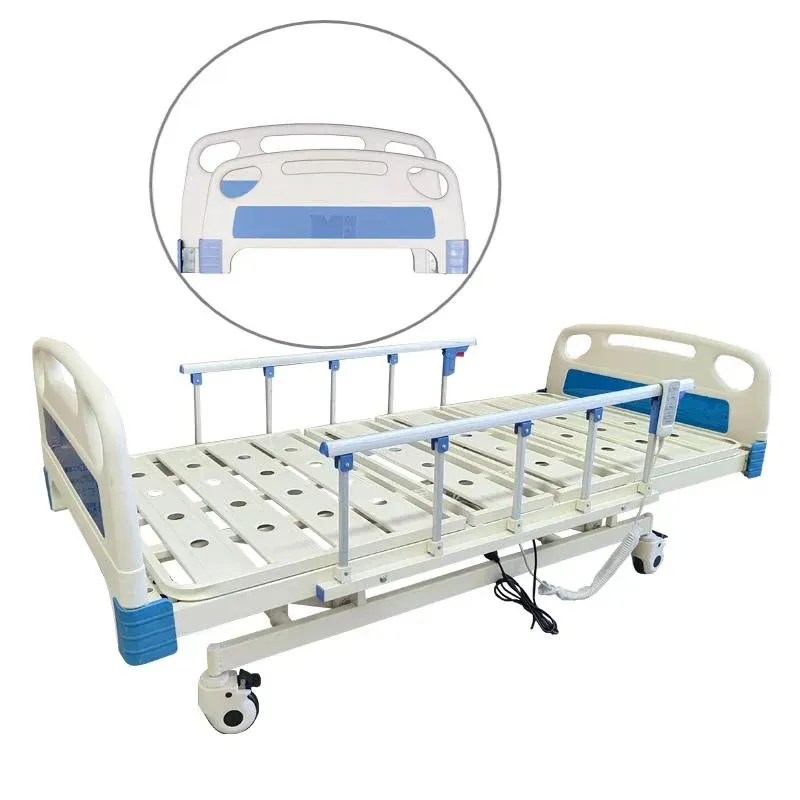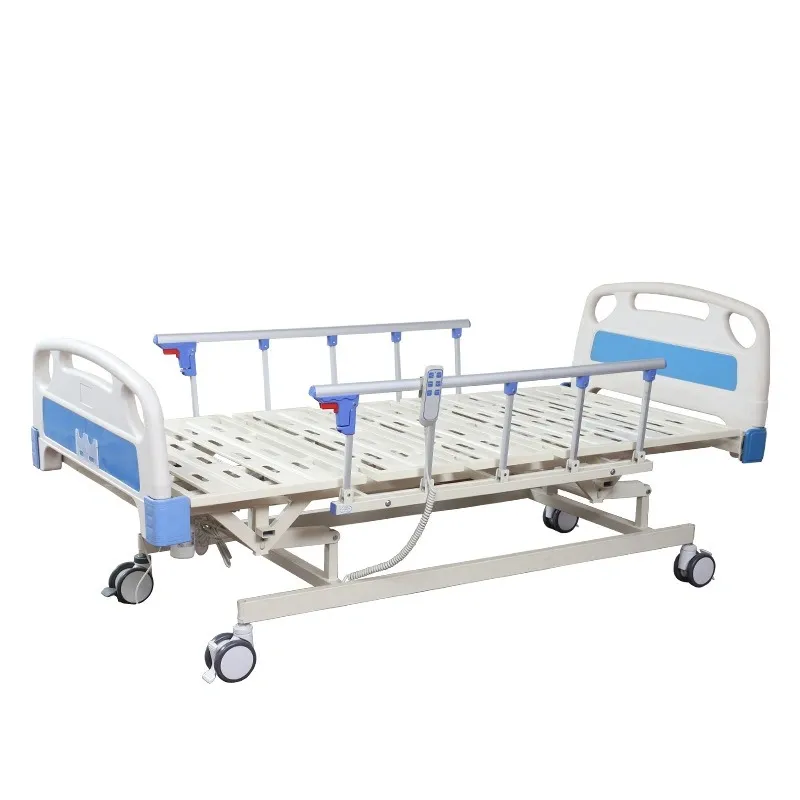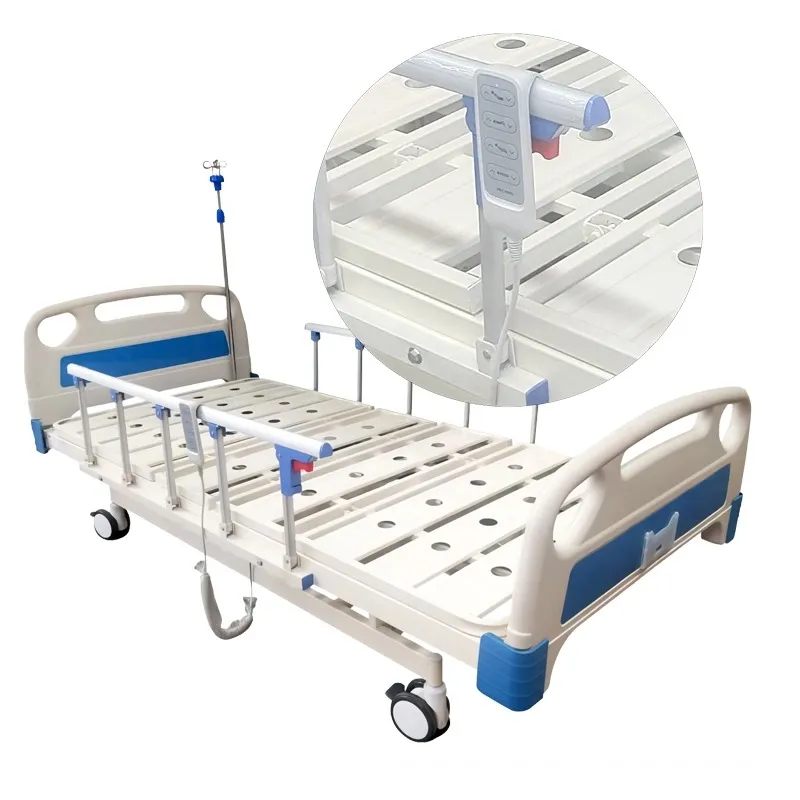Advanced ICU Hospital Bed: Comfort, Safety & Reliability
The Critical Role and Advanced Engineering of ICU Hospital Beds
In the demanding environment of modern healthcare, the role of specialized medical equipment is paramount. Among these, the icu hospital bed stands as a cornerstone, providing not only comfort but also crucial therapeutic support and safety for critically ill patients. These sophisticated devices are engineered to meet the stringent requirements of Intensive Care Units (ICUs), offering dynamic patient positioning, integrated safety features, and robust construction. The global market for ICU beds is witnessing continuous innovation, driven by an aging population, rising chronic diseases, and technological advancements aiming to enhance patient outcomes and improve caregiver efficiency.
The selection of an appropriate ICU bed involves a comprehensive evaluation of its technical specifications, manufacturing integrity, and long-term cost-effectiveness. Hospitals and medical facilities increasingly seek solutions that offer an optimal balance between advanced functionality and investment efficiency, often considering factors like icu hospital bed cost and long-term operational expenses. This article delves into the intricate details of modern ICU hospital beds, from their meticulous manufacturing processes to their pivotal application in critical care settings, emphasizing the blend of engineering precision and patient-centric design that defines these vital medical devices.
Precision Manufacturing Process of an ICU Hospital Bed
The production of a high-quality icu hospital bed is a complex, multi-stage process requiring rigorous adherence to international standards and precision engineering. This ensures durability, patient safety, and optimal functionality throughout its service life. The manufacturing journey typically involves several key phases:
1. Material Selection and Preparation:
- Structural Components: High-grade carbon steel or alloy steel tubing is selected for the bed frame, known for its superior strength-to-weight ratio and fatigue resistance. For bed platforms, cold-rolled steel sheets with perforations are common to allow for mattress ventilation and prevent pressure sores.
- Patient Contact Surfaces: ABS (Acrylonitrile Butadiene Styrene) or PP (Polypropylene) plastics are utilized for headboards, footboards, and side rails due to their impact resistance, ease of cleaning, and chemical resistance to common disinfectants.
- Actuators and Electronics: High-performance, low-noise electric motors (e.g., DC linear actuators) are sourced for precise and smooth adjustments. Control systems, including remote pendants and nurse controls, are built with medical-grade components conforming to electromagnetic compatibility (EMC) standards.
2. Frame Fabrication and Machining:
- Cutting and Bending: Steel tubes and sheets undergo precise CNC (Computer Numerical Control) laser cutting and bending to form frame components. This ensures dimensional accuracy critical for subsequent assembly and smooth operation of articulated sections.
- Welding: Robotic welding techniques are employed to join frame components, guaranteeing consistent, high-strength welds. This minimizes human error and ensures structural integrity, crucial for the bed’s load-bearing capacity.
- Surface Treatment: After welding, frames are cleaned and pre-treated to remove impurities. Electrostatic powder coating is then applied, providing a durable, anti-corrosive, and aesthetically pleasing finish that can withstand harsh hospital cleaning protocols.
3. Assembly and Integration:
- Mechanical Assembly: Articulated bed sections, lifting mechanisms, and wheel systems are assembled with high-tolerance fasteners and bearings.
- Electrical and Electronic Integration: Motors, control units, and wiring harnesses are installed and meticulously connected. Safety features like battery backup, CPR release mechanisms, and nurse call integration are fitted.
- Component Attachment: Headboards, footboards, side rails, and accessory mounting points are secured.
4. Quality Control and Testing Standards:
Every icu hospital bed undergoes rigorous testing to comply with international medical device standards. This includes:
- ISO 13485: Certification for Medical Devices Quality Management Systems, ensuring consistent product quality.
- IEC 60601-1: General requirements for basic safety and essential performance of medical electrical equipment.
- ANSI/AAMI ES60601-1: Equivalent US standard for electrical medical equipment safety.
- Load Testing: Verification of safe working load (SWL) and maximum patient weight capacity.
- Cycle Testing: Actuators and moving parts are tested over thousands of cycles to ensure longevity and reliable operation.
- Electrical Safety Tests: Dielectric strength, leakage current, and grounding integrity.
The typical service life for a well-maintained electric ICU hospital bed ranges from 8 to 15 years, depending on usage intensity and maintenance. Target industries for these advanced beds primarily include critical care units in hospitals, emergency departments, long-term acute care facilities, and specialized surgical recovery centers. Advantages in typical application scenarios include enhanced energy saving through efficient motor design, superior corrosion resistance from powder coating, and improved patient safety via robust construction and intelligent control systems.

Technical Specifications and Performance Parameters
Understanding the technical specifications of a icu hospital bed is crucial for procurement decision-makers. The "High quality electric three-function medical bed" is designed to offer critical functionality and reliability. Key parameters differentiate basic beds from those built for intensive care.
Product Specification Table: High Quality Electric Three-Function Medical Bed
| Parameter | Specification | Significance for Critical Care |
|---|---|---|
| Overall Dimensions | L 2150mm x W 950mm x H (450-750mm) | Accommodates a wide range of patient sizes; adjustable height aids caregiver ergonomics and patient transfer. |
| Back-rest Lifting Angle | 0-80° (±5°) | Supports respiratory function, comfortable eating, and prevents aspiration; crucial for patient comfort and therapy. |
| Leg-rest Lifting Angle | 0-40° (±5°) | Promotes blood circulation, reduces edema, and enhances lower limb comfort. |
| Height Adjustment | 450mm to 750mm | Facilitates safe patient entry/exit, caregiver access for procedures, and reduces strain. |
| Safe Working Load (SWL) | 250 kg | Ensures the bed can safely support bariatric patients and medical equipment without compromise. |
| Motors | Quiet, powerful DC electric motors (e.g., Linak, Timotion equivalent) | Smooth, reliable adjustments with minimal noise, essential for patient rest and a calm ICU environment. |
| Side Rails | Detachable ABS side rails with integrated controls (optional) | Prevents patient falls, easy to clean, and controls facilitate patient self-adjustment or nurse intervention. |
| Casters | φ125mm noiseless casters with central braking system | Ensures smooth, quiet mobility for patient transport and secure locking for stability. |
| Certifications | ISO 13485, CE (MDR 2017/745), FDA (optional) | Guarantees adherence to international quality and safety standards for medical devices. |
These specifications highlight the core functionality and safety features integral to a reliable icu hospital bed. The emphasis on robust construction, versatile positioning, and patient safety mechanisms underscores its crucial role in critical care management.
Application Scenarios and Strategic Advantages
The versatility and advanced features of modern ICU beds make them indispensable across a spectrum of critical care environments. Their design addresses both patient needs and caregiver efficiency, leading to tangible advantages.
Primary Application Scenarios:
- General ICUs: Providing dynamic patient positioning for ventilation, preventing pressure injuries, and facilitating nursing procedures.
- Emergency Departments: Enabling rapid patient assessment, resuscitation, and comfortable stabilization before transfer.
- Post-Operative Recovery Units: Supporting patients through the immediate post-surgical phase, allowing for precise adjustments to manage pain and facilitate recovery.
- Long-Term Acute Care (LTAC) Facilities: Offering durable and comfortable solutions for patients requiring extended critical care.
Key Technical and Operational Advantages:
- Enhanced Patient Comfort and Safety: Multi-positioning capabilities (e.g., Trendelenburg/Reverse Trendelenburg, Fowler, Semi-Fowler) improve patient comfort, aid in respiratory management, and reduce the risk of pressure ulcers. Integrated side rails with patient controls empower patients while ensuring fall prevention.
- Improved Caregiver Ergonomics: Electric height adjustment and articulation reduce physical strain on nurses and medical staff during patient care, transfers, and examinations, thereby reducing occupational injuries.
- Infection Prevention: Smooth surfaces, minimal crevices, and the use of medical-grade plastics and powder-coated steel facilitate thorough cleaning and disinfection, crucial for infection control in ICUs.
- Integration with Medical Equipment: Designed with accessory mounting points for IV poles, drainage bags, and compatibility with patient monitoring systems, ensuring a seamless critical care environment.
- Durability and Longevity: Constructed with high-strength materials and subjected to stringent testing, these beds offer exceptional reliability and a long operational lifespan, providing excellent value for the icu hospital bed price.

Industry Trends and Future Innovations in ICU Bed Technology
The landscape of critical care is constantly evolving, and so too are the technological advancements in icu hospital bed design. Current industry trends point towards greater integration, intelligence, and patient-centric features.
- Smart Bed Technology: Integration of IoT sensors for continuous monitoring of vital signs, patient movement, and bed exit detection. AI algorithms can predict patient risk factors like pressure injuries or falls, alerting caregivers proactively.
- Remote Monitoring and Control: Capabilities for healthcare professionals to monitor and adjust bed parameters remotely, enhancing efficiency, especially in scenarios with staff shortages.
- Antimicrobial Surfaces: Development and application of materials with inherent antimicrobial properties to further reduce healthcare-associated infections (HAIs).
- Modular and Customizable Designs: Beds are becoming more modular, allowing for easier upgrades, replacement of components, and customization to specific clinical needs or hospital layouts.
- Enhanced Mobility and Transport: Improved caster systems, power-drive assist, and integrated handles to facilitate easier and safer patient transport within the facility.
- Energy Efficiency: Adoption of more efficient motor systems and power management to reduce operational costs and environmental impact, an important consideration for the overall icu hospital bed cost.
These innovations are set to redefine critical care, making ICU beds not just support structures but active participants in patient recovery and safety protocols.
Vendor Comparison and Customized Solutions
When considering an icu hospital bed for sale, comparing vendors is crucial. Beyond the initial icu hospital bed price, factors like build quality, feature set, certifications, and after-sales support significantly impact the total cost of ownership and long-term reliability. Below is a conceptual comparison showcasing key differentiation points:
ICU Hospital Bed Vendor Comparison (Illustrative)
| Feature/Criterion | ZhaofaMed (High Quality Electric Three-Function Medical Bed) | Competitor A (Standard ICU Bed) | Competitor B (Economy ICU Bed) |
|---|---|---|---|
| Motor System Reliability | High-grade DC motors (e.g., Linak/Timotion equivalent), 10,000+ cycle life. | Good quality DC motors, 5,000-8,000 cycle life. | Basic DC motors, 3,000-5,000 cycle life. |
| Safety Certifications | ISO 13485, CE (MDR), FDA registered (optional). | ISO 13485, CE (MDD). | Basic medical device certification. |
| Material Quality (Frame) | Premium cold-rolled steel, robotic welding, epoxy powder coating. | Standard cold-rolled steel, manual welding, powder coating. | Basic steel, manual welding, paint finish. |
| Advanced Features | Central braking, CPR quick release, nurse control panel, optional battery backup. | Individual wheel brakes, basic patient pendant. | Manual brakes, basic controls. |
| Warranty Period | 2 years for motors, 5 years for frame. | 1 year for motors, 3 years for frame. | 1 year overall. |
| Customization Options | Extensive: mattress types, color options, accessories, embedded controls. | Limited: mattress upgrades, basic accessories. | Minimal. |
Customized Solutions: Tailoring the ICU Bed to Specific Needs
Recognizing that every healthcare facility has unique requirements, reputable manufacturers offer tailored solutions for their icu hospital bed offerings. This ensures that the bed integrates seamlessly into existing infrastructure and addresses specific patient demographics or clinical protocols. Customization options can include:
- Mattress Integration: Compatibility with specialized pressure-relieving mattresses, alternating pressure mattresses, or low-air-loss systems for patients at high risk of pressure injuries.
- Control System Variations: Options for integrated side rail controls, patient hand pendants, or advanced nurse control panels with lockout functions.
- Accessory Options: Integration of IV poles, oxygen cylinder holders, drainage bag hooks, overhead traction frames, and central monitoring system interfaces.
- Color and Aesthetics: Custom color schemes for specific hospital branding or ward differentiation.
- Specialized Configurations: Adapting dimensions or specific functionalities for bariatric patients, pediatric ICU, or specialized surgery recovery units.

Application Case Study: Enhancing Critical Care Efficiency
A major regional hospital, "St. Jude's Medical Center," with a 30-bed ICU, faced challenges with aging hospital beds. These older beds lacked advanced positioning capabilities, requiring manual adjustments and increasing the risk of pressure ulcers. Furthermore, their unreliable motors led to frequent maintenance, impacting patient flow and staff morale. The administration sought a reliable, feature-rich icu hospital bed solution that would improve patient outcomes and caregiver efficiency, while offering a competitive icu hospital bed cost.
Solution Implementation:
St. Jude's Medical Center procured 30 units of the High Quality Electric Three-Function Medical Bed. The beds were selected for their robust construction, intuitive nurse control panels, integrated side rails with patient controls, and adherence to international safety standards (ISO 13485, CE). The central braking system and smooth-rolling casters were also key factors, improving intra-hospital patient transport efficiency.
Results and Impact (12-Month Post-Implementation):
- Reduction in Pressure Ulcers: The advanced positioning capabilities and compatibility with specialized mattresses contributed to a 35% reduction in hospital-acquired pressure ulcers within the ICU.
- Improved Staff Ergonomics: Nurses reported a significant reduction in physical strain due to the electric height and position adjustments, leading to a 20% decrease in reported musculoskeletal injuries related to patient handling.
- Enhanced Patient Satisfaction: Patients and their families frequently cited the comfort and ease of adjustment as positive aspects, contributing to a 15% increase in patient satisfaction scores related to their environment.
- Operational Efficiency: The reliability of the beds and reduced maintenance requirements led to less downtime, improving bed turnover rates and overall ICU capacity utilization by 10%.
- Cost Savings: While the initial icu hospital bed price was a considered investment, the reduction in pressure injury treatment costs, fewer staff injuries, and lower maintenance expenses resulted in an estimated 18% cost saving over the first year compared to previous operational costs.
This case study exemplifies how investing in high-quality, technically advanced ICU beds can lead to substantial improvements in patient care, staff well-being, and operational efficiency, validating the long-term value over initial purchase considerations.
Frequently Asked Questions (FAQ)
Q1: What are the key differences between a standard hospital bed and an ICU hospital bed?
A1: While both provide patient support, an icu hospital bed typically offers more advanced functionalities such as precise multi-directional electric articulation (Trendelenburg/Reverse Trendelenburg, Cardiac Chair position), higher weight capacities, integrated nurse control panels, battery backup, CPR quick-release functions, and often compatibility with specialized critical care accessories. These features are designed to address the complex needs of critically ill patients and the demanding environment of an ICU.
Q2: What is the typical lead time for a bulk order of ICU hospital beds?
A2: For standard models, lead time typically ranges from 30 to 45 business days for manufacturing and quality control, followed by shipping time which varies based on destination. For customized solutions or very large orders, this may extend to 60-90 days. We recommend consulting our sales team for precise lead time estimates based on your specific order and destination, especially when considering an icu hospital bed for sale.
Q3: What is the warranty policy for the High Quality Electric Three-Function Medical Bed?
A3: We offer a comprehensive warranty: 5 years for the main bed frame (structural integrity) and 2 years for electrical components and motors. This warranty covers manufacturing defects and material failures under normal use and proper maintenance. Detailed terms and conditions are provided with each purchase.
Q4: How does your company ensure after-sales support and spare parts availability?
A4: We are committed to robust after-sales support. This includes remote technical assistance, detailed user manuals, and online troubleshooting guides. Spare parts for critical components, such as motors, control units, and structural elements, are readily available for rapid dispatch to minimize downtime. Our global network ensures timely support wherever our beds are deployed.
Conclusion
The modern icu hospital bed is a testament to advanced engineering and a deep understanding of critical care needs. From its meticulous manufacturing process, adhering to stringent international standards, to its sophisticated technical features and customizable solutions, it plays an indispensable role in enhancing patient safety, comfort, and recovery. Investing in high-quality ICU beds represents a strategic decision for healthcare facilities, yielding benefits far beyond the initial purchase price, contributing significantly to operational efficiency, staff well-being, and ultimately, superior patient outcomes. As the healthcare industry continues to evolve, the integration of smart technologies and patient-centric design will further solidify the ICU bed's position as a vital, intelligent component of the critical care ecosystem.
References
- World Health Organization. Medical devices: Managing the life-cycle. 2010.
- International Organization for Standardization. ISO 13485:2016 Medical devices — Quality management systems — Requirements for regulatory purposes.
- International Electrotechnical Commission. IEC 60601-1: Medical electrical equipment — Part 1: General requirements for basic safety and essential performance.
- Journal of Clinical Nursing. The impact of bed mobility on patient and nurse safety. 2018.




































